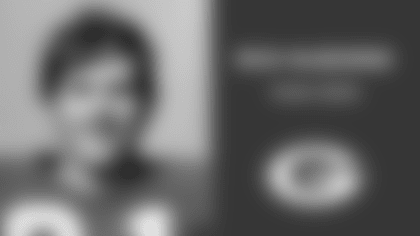More than any other position in football, offensive line coaches talk to each other and usually arrive at a consensus about the pecking order of talent in the draft. Also, the offensive line is the one area on a team where substitutions are few, be it during games or the season.
Players drafted in the first three rounds usually play a lot of football early in their careers. Offensive line coaches believe that their players need to work in harmony, and refuse to think there is a down-and-distance situation that is cause for a substitution.
Drafted offensive linemen are usually considered "safe" picks, and what everyone hopes for is that they select one that will be considered a "10-year guy." Last year's draft produced six of those guys for sure, and maybe another four are close to that status already. In fact, I haven't spoken with one offensive line coach who sees that kind of group in the 2003 draft. One respected coach told me, "Try half that number this year."
On the other hand, every team carries 10 linemen on the roster, which means more than 320 offensive linemen collect paychecks from NFL teams. My advice to teams drafting offensive linemen is this: Don't wait until the second day. It's a lean year, and it's not by chance that players drafted in Rounds 1-3 dominate the starters in this league. Last year, 16 offensive linemen went on the first day, and 11 landed as full-time starters by the end of the season.
What head coaches and personnel people look for first in the draft is a premier left tackle, then a right tackle, followed by centers and guards. The top tackle candidate is Jordan Gross (Utah) hands down. He's a former tight end with very good athleticism, and can be nasty on the field. When I asked coaches to stack him up against last year's first-round tackles -- Mike Williams, Bryant McKinnie, Levi Jones, Marc Colombo and Kendall Simmons (who is now a guard) -- Gross was placed third or fourth. He's still a top-10 pick this year, but where? Most agree he won't fall past Carolina at No. 9, but I spoke with one line coach who believes his team will try and slide into a spot before Carolina to take Gross.
The next lineman to go in the first round could be Eric Steinbach (Iowa) or Kwame Harris (Stanford). Steinbach is the most versatile lineman because he can play at all the positions and compete, which makes him a safe pick. He will be drafted, and barring injury, will play all 16 games next year, probably at guard.
Harris is more of a project and will need time to develop. According to a line coach who went out to Stanford to work him out, "Harris could have used an extra year in school to become the top prospect. He will struggle early in his career and eventually become a top player."
For most of the winter, George Foster (Georgia) was the next guy with a first-round grade. But as of now, he has slipped closer to the second round and may eventually be passed by Wayne Hunter (Hawaii). As I said, line coaches talk among themselves, and the word got out about Hunter's athleticism and feet to pass block.
Once again, as it relates to last year, the second round produced five full-time starting linemen. Mike Pearson started 11 games for Jacksonville at left tackle. Hunter and Foster would be lucky to have rookie seasons as good as Pearson.
One piece of good news about this class is at center, where Jeff Faine (Notre Dame) sits atop the list. He has remarkable measurables and is tenacious on the field. He could be a very late first-round selection, which is rare for centers. After Faine, I like Dan Koppen (Boston College), who impressed me at the Senior Bowl. When I watched tape of him against Miami with all of its first-round talent, he was impressive.
The guards in this draft are second- and third-round types, except for Steinbach. The big Hawaiian, Vince Manuwai, stood out at the Senior Bowl. And if you need a powerful run blocker, hope your team selects Montrae Holland (Florida State). One college scout said of Holland, "He should be able to do everything Toniu Fonoti did for the Chargers as a rookie." Fonoti started 14 games and opened up holes for LaDainian Tomlinson's 1,683 rushing yards.
Keep in mind, more linemen than last year's 20 will be drafted on the second day, during Rounds 4-7. If last year's numbers are any indication of the future, don't expect too much help for your favorite team from second-day linemen. Those 20 linemen only produced 22 starts. A dozen came from Eric Heitmann in San Francisco. Another eight came from Tyson Walter in Dallas. That means the other 18 draft picks produced just two starts.
Kirwan's Hot Topics
Some key points to keep in mind as we watch the draft unfold:
- Will someone move into a spot between No. 5 and No. 8 to take Jordan Gross, or will Carolina move up a spot or two to prevent someone from taking him?
- Will Jeff Faine go to the Raiders with the last pick in the first round to replace Barrett Robbins, or has Oakland resolved its issues with him?
- Will a team reach for Wayne Hunter in the first round as he gains momentum in the last two weeks of the evaluation process?
- Do the Texans grab a quality tackle early and cast more doubt on the long-term health of Tony Boselli?
- Are the Rams really willing to trade Orlando Pace, and is some team that has studied this draft class now ready to pull the trigger?














